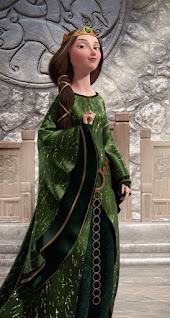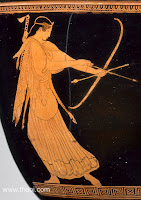Maiden, Mother, and Crone: Three Powerful Women in Brave
Brave has always been one of my favorite animations as a child, but rewatching it as an adult was a roller coaster of its own. However, I found it pretty mesmerizing to witness a change in perspective in my own head and reunite my childhood experience and the one as an adult.
Brave has a lot to say when looked upon as not only a kids' movie but also a mixture of women's struggle to love and take control of their lives, battle with tradition, magic, and fate. In this blog I'm going to talk about how the three central women of Brave (Merida, her mother Queen Elinor, and the nameless witch of the woods) fit in the Triple Goddess concept and also include character analysis and folkloric background about them.
Warning: spoilers ahead.
Brave is set in the Scottish Highlands during the Middle Ages and is the story of a princess, but not just any princess. It's the story of Merida, a princess and a skilled archer who fights for her freedom and her right to choose her own life. When she's sixteen years old, she's expected to marry one of the firstborn sons of the 3 lords that wins the archery challenge. Queen Elinor, Merida's mother, is a kind but strict mother who teaches Merida to become the proper, ladylike, and royal princess for the traditional arranged marriage.
Merida, on the other hand, is not satisfied with the way things are going and seeks her freedom as a young woman. After a series of events, Merida, who's fed up with the situation, leaves the castle on horseback after a fight with her mother and finds herself in an old witch's hut. She asks for a spell that would change her mother so her fate will change as well. The witch conjures a tart for Merida to give to her mother.
Queen Elinor feels sick after eating the tart and transforms into a bear. Queen Elinor and Merida leave the castle and start a journey of emotional bonding and healing while they look for a way to turn Queen Elinor back to her human shape. The story concludes with Queen Elinor transforming back to her human form and Merida apologizing for what she did. Eventually their mother-daughter bond strengthens and blossoms with a new start. They gain a deeper understanding of each other's point of view on life and love.
The Triple Goddess Concept and Female Life Cycle
Maiden, Mother, and Crone, or the Triple Goddess, is a Neopagan archetype representing three aspects of a female deity. It often symbolizes the stages of a woman's life: These correspond to phases of the moon (new, full, waning), seasons (spring, summer, winter), and life stages (youth, adulthood, old age).
In Brave, the three central female figures can be interpreted through this concept. The maiden is Merida because she resists traditional values and reflects youth, independence, and potential in her character. She has to be prepared for marriage, but due to her refreshing nature and motifs of springs, she wants to change the rules and write them anew.
Queen Elinor is the mother of our trio. She represents maturity and responsibility. She deeply cares for Merida and nurtures her sons throughout the movie. Her transformation into a she-bear doesn't change her qualities as a mother, as she cares for Merida even more, puts her life on the line for her children, and enhances her qualities as a protective but sometimes restrictive mother.
The nameless witch of the woods, as the crone, makes our cycle complete. A long-lived old woman who possesses ancient knowledge and magical power aligns perfectly with the crone. She's a mysterious figure in the movie, as we don't get a lot of details about her life during the movie, but she's associated with the darker aspects of femininity. The witch can transform and manipulate the fates of other people like Merida and the villain of our story, Mordu. The crone is associated with death, rebirth, and the underworld, which resonates with the witch's powers and lifestyle in Brave.
Let's go through the characters one by one!
Celtic mythological elements like will-o'-the-wisps and her obsession with them add to this aspect. The will-o’-the-wisps are from Scottish folklore. They are said to lead travelers to treasure or doom, and they can change your fate. They are seen as blue flames created by swamp gases interacting with natural resources. People who followed them would basically drown or get sucked down.
My ultimate favorite character in Brave is Queen Elinor. She's represented as a powerful queen and a strict mother who cares for the traditional motifs. She goes through a massive character development as the story goes on. Her transformation into a bear not only strengthens her relationship with her only daughter but also reforms her view on life and traditional values.
Let's talk a bit about bear mythology. Elinor's transformation into a she-bear is heavily inspired by the Celtic bear goddess, Artio. This goddess is linked to cycles of nature, spring in particular. She's said to sleep during winter and wake up with the plants and animals in spring.
In Greek mythology, the goddess Artemis is heavily associated with bears. She's the goddess of hunting, the wilderness, and wild animals. She's also a goddess of childbirth and the protector of the girl child up to the age of marriage. Artemis is usually depicted as a young maiden with a hunting bow and quiver of arrows. Apart from deer, bears were also sacred to Artemis, as well as a variety of water and ground birds. So it's safe to say that Queen Elinor is a stand-in for Artemis or Artio.
One of the extremely powerful Celtic goddesses is The Cailleach Béara, who is associated with Irish and Scottish legends. 'Cailleach' is actually the Gaelic word for an old hag or crone, as she forms a part of the Great Goddess Trinity not only as the crone but also as the maiden and mother. Caileach is most probably the inspiration behind the witch in the woods.
Some old Gaelic terms suggest that Caileach is a wise spiritual woman who mostly covers her face and is a charm-worker to hide the negativity surrounding witchcraft that was induced by patriarchy. It's safe to say that the witch in Brave has chosen to live the life of a simple woodcarver, making bear-themed charms in a cottage deep in the woods, and also using her magic to help others from time to time.
Caileach was a respected and feared folk figure among the locals. With her witch-like energy, she is known to be a creator, most specifically of landscapes. The witch in our story can turn doors to portals and humans to animals, but we don't get to see her other powers, as her character doesn't go through enough development due to the fact that her role is over after she hands in the spell to Merida and leaves for the Wicker Man Festival in Stornoway.
Caileach is described as a one-eyed, dark blue-skinned giant goddess who wears a hood and carries a staff that freezes the ground. The witch in Brave also has one eye slightly closed, using just one eye instead of two as she focuses on Merida. As I mentioned, her character development isn't really included in the animation, but she also carries a staff around like Caileach.

.jfif)

.jfif)








.jfif)
.png)
Comments
Post a Comment